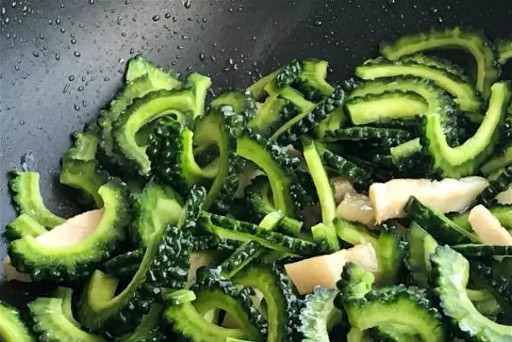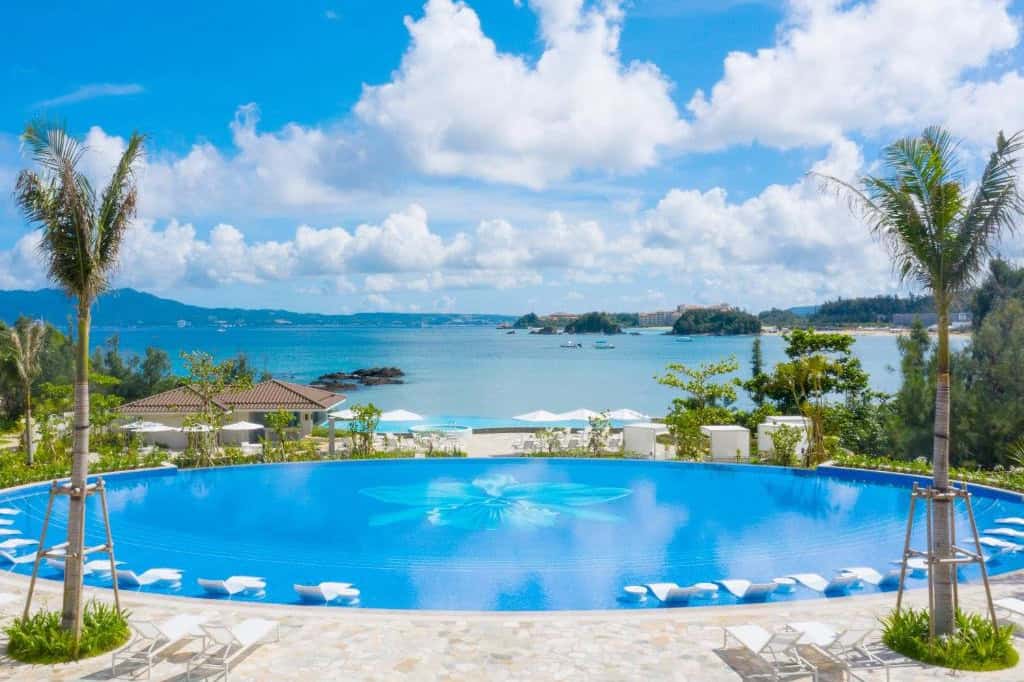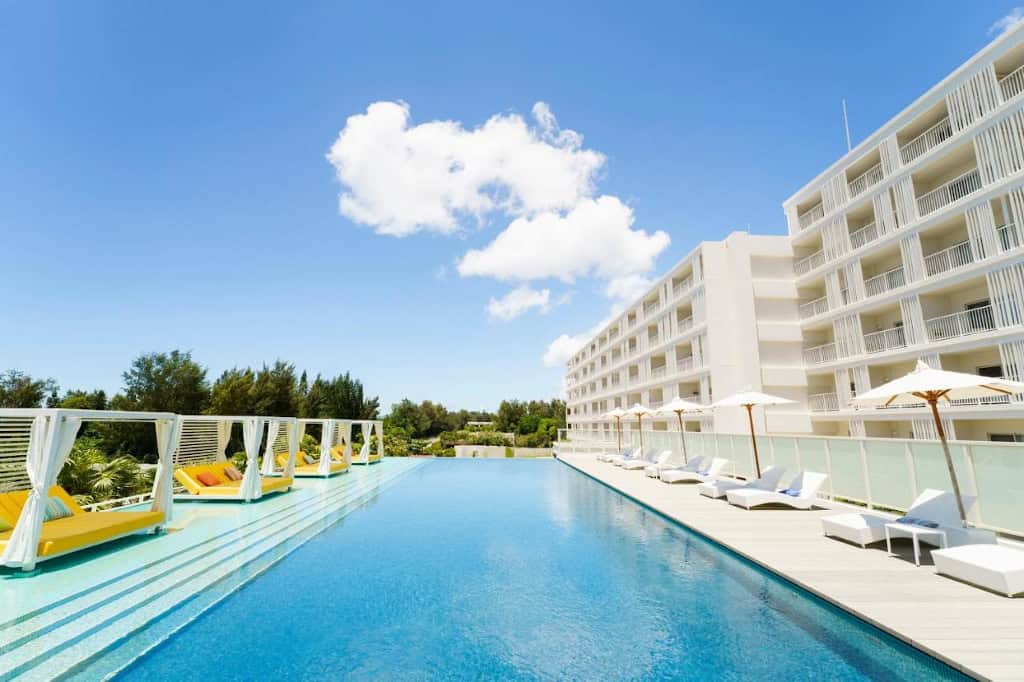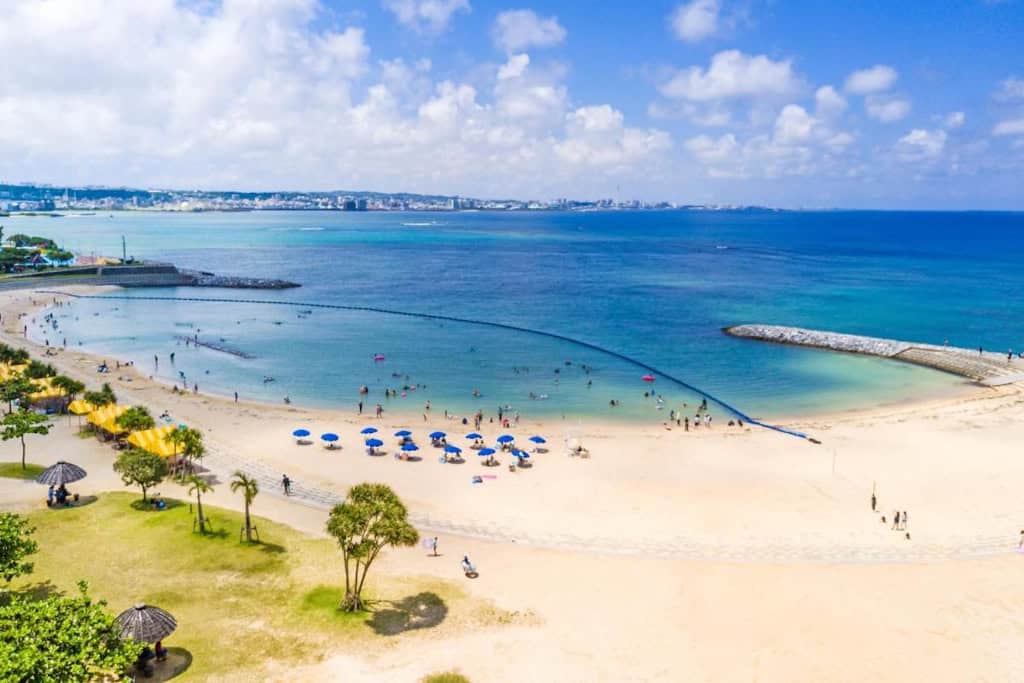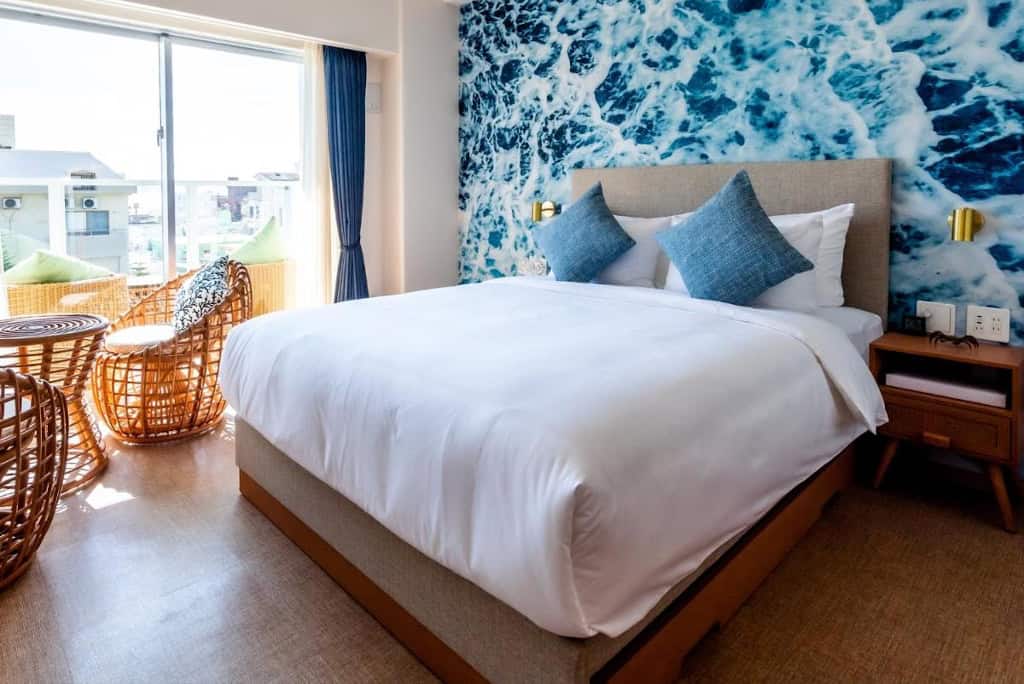Discover Okinawa

Looking to escape the mainland crowds? Okinawa's subtropical island offers the ultimate Japanese getaway.
Soak up the East China Sea's turquoise waters and relax on its golden sand beaches. Delve into the vibrant Ryukyu Kingdom culture at historic sites like Shuri Castle. Snorkel along kaleidoscopic coral reefs or simply unwind with an Orion beer in hand.
From the main Okinawa Island to remote Yaeyama jewels like Ishigaki, Okinawa delivers a truly distinctive island experience.
Get ready to embrace Japan's sun-soaked southwestern frontier!
Get my free Japan Travel Bulletin:
Discover Okinawa - Japan's Subtropical Paradise Unveiled
by Rob Dyer
The first time I went to Okinawa I was so surprised by what I saw.
This wasn’t the Japan I’d seen in the media when I was growing up. I didn’t even know Japan had regions with subtropical jungles. Visiting Okinawa gives you an experience of Japan that’s nothing like any of its better-known counterparts.
This introductory guide focuses on Okinawa Island, but also touches on some of the other, smaller islands included within the larger Okinawa Prefecture.

The waters surrounding Okinawa Island are full of life among the coral reefs
Where is Okinawa?
Okinawa Island is the largest of Japan's southern-most islands and is surrounded by the Pacific Ocean and East China Sea to the northwest. It's located 640km (400mi) south of the island of Kyushu. If you were to fly from Tokyo to Naha, the capital of Okinawa Island, it's over 1,500km (950mi) and typically takes between 2hr 40min to 3 hours.
Okinawa Location Map
Introducing Okinawa
Okinawa is Japan’s fifth largest island with an area of 1,206 sq km (466.02 sq mi), and has a unique culture, history, and natural environment that sets it apart from the rest of Japan. The islands were once part of the independent Ryukyu Kingdom, which had strong cultural and trade ties with China before being annexed by Japan in the late 19th century. This legacy is still visible today in Okinawan architecture, cuisine, and traditions.
Because of its remote location and historical influences it stands out as Japan’s most culturally diverse region.
VIDEO: Okinawan Folk Music, Ishigaki Island
Okinawa Facts & Figures
Okinawa is the fifth largest island in Japan, after Honshu, Hokkaido, Kyushu and Shikoku. It's located in the Pacific Ocean, around 1,554km (966mi) from Tokyo. The population of Okinawa in 2022 was 1.4M people.

Since the Battle of Okinawa and the end of World War II, Okinawa has been a strategic location for the United States Armed Forces, and was formally controlled by the United States Civil Administration of the Ryukyu Islands until 1972. Today there are around 26,000 U.S. military personnel stationed on Okinawa - something that not all Japanese are happy about.
The climate and seasons in Okinawa
CURRENT WEATHER
Okinawa has a subtropical climate, with hot, humid summers and mild, dry winters. Average temperatures range from around 68°F (20°C) in January to 86°F (30°C) in July. Okinawa also experiences a rainy season from May to June, as well as the potential for typhoons during the summer months.
The island's southern location means it has the warmest weather in Japan, making it a popular destination for beach vacations, snorkelling, and diving year-round. The prime time to visit is generally during spring and autumn, when the weather is at its best, avoiding the rainy and typhoon seasons during the unpredictable summer months.
My wife and I like to head to Okinawa outside of the summer and hotter months. It's ideal for a winter sunshine get away from the rest of Japan.

Okinawa's coastline is chock-full of gorgeous sandy beaches and quiet hidden coves
When to visit Okinawa
The best time to visit Okinawa depends on your interests and preferences. But it’s worth noting up front that during the summer period there is a rainy season (mid-May to late June) and a typhoon season (start of July to end of October).
Spring (March-May)
Spring is a idyllic time in Okinawa, with mild temperatures, low rainfall, and the blooming of the islands' iconic flowers like bougainvillaea. This is a great season for outdoor activities and exploring Okinawan culture.
Summer (June-August)
Summer brings hot, humid weather, but also the best conditions for water sports and beach vacations. Typhoon season runs from July to October, so check forecasts if visiting during this time.

Dragon icons can be found all over Okinawa and originate in legends from the era of Ryukyu Kingdom
Fall (September-November)
Autumn sees lower humidity and temperatures, making it an ideal time for hiking and sightseeing. The autumn foliage in the northern part of Okinawa Island is also worth seeking out at this time of year.
Winter (December-February)
Winters in Okinawa are mild, with average highs around 68°F (20°C). This is the dry season, perfect for exploring Okinawa's historic sites and enjoying the islands' slower pace and fewer tourists. If you're not keen on the colder temperatures found in the north, then Okinawa is the perfect retreat for some winter sun.
SEE ALSO: The Best Time To Visit Japan – All You Need To Know

Shureimon Gate is the entrance to Shuri Castle in Naha - also known as the 'red castle'
Top attractions and highlights of Okinawa
The Blue Cave
Okinawa's Blue Cave is a well-known spot for diving and snorkelling and is suitable for novice divers. It's located at Cape Maeda close to Onna Village - a 50 minute drive or around 1.5 hours by bus north of the capital Naha. This is one of the biggest draws for visitors to the island.
It's a semi-submerged limestone cave which is sea-facing, meaning sunlight streams inside during the day, reflecting off the white sea floor, thus giving the cave its name. Visit between dawn and noon for the perfect combination of light and water colour.
Top Blue Cave Experiences
Shuri Castle, Naha
Once the political and cultural heart of the Ryukyu Kingdom, Shuri Castle in Naha is an impressive example of Ryukyuan architecture and part of a UNESCO World Heritage site. Highlights include the beautifully restored red-lacquered castle walls (it's often referred to as the 'red castle') and gates, as well as the royal throne room.
You can find an image of the Shureimon Gate entrance to Shuri Castle on the ¥2,000 bank note.
Okinawa Churaumi Aquarium, Motobu

Okinawa Churaumi Aquarium is one of the largest aquariums in the world
Located on the northern tip of the large Motobu Peninsula, the impressive Okinawa Churaumi Aquarium is one of the largest aquariums in the world (was once the largest). It's renowned for its massive main tank, which allows you to view whale sharks, manta rays, and other large marine life up close.
Top Churaumi Aquarium Experiences
Hedo Misaki (Cape Hedo), Kunigami
The northernmost point of Okinawa Island, Hedo Misaki features dramatic cliffs overlooking the crashing waves of the East China Sea. It's a great spot for taking photos, especially at sunset. On clear days, the island of Yoron in Kagoshima Prefecture can be seen on the horizon 23 kilometres (14 mi) away.
Okinawa Peace Memorial Park, Itoman
This solemn park in Itoman commemorates the Battle of Okinawa, one of the bloodiest battles of World War II. The Okinawa Prefectural Peace Memorial Museum and the towering Cornerstone of Peace monument are the park's main draws. It's situated on Mabuni Hill, the site where the Battle of Okinawa ended.
Top Okinawa Cultural Experiences
Tokashiki Island
Tokashiki, southwest of Okinawa, is the largest island in Keramashoto National Park and is known for its pristine white sand beaches, clear turquoise waters, and fantastic snorkelling and diving. It's a popular day trip or short stay destination for visitors. Accommodation is mainly relaxing guesthouses, but a few premium resorts also have a presence here.
The rugged island covers 15 square kilometres (9 sq mi). Ferries operate to Tokashiki Island from Naha, and tour operators on the main island offer day-trip excursions.

My wife and I snorkelling in Okinawa for the first time
What to do in Okinawa
Okinawa offers a diverse array of activities and experiences for travellers, from cultural exploration, to plenty of outdoor and water-based adventures.
Soak in Okinawa's oceans
Simply soak or swim in the stunning clear waters of the Pacific Ocean that surround its intricate coastline. You’ll be spoilt for choice and the best spots tend to be north of the capital Naha.

One of Okinawa's many Pacific Ocean beaches | Photo: Mats Franzen
Onsen are rare in Okinawa (its nearest large neighbour island Kyushu offers an abundance if that’s what you’re after.) There's one hot spring hotel on the tiny island of Senaga - Senagajima Island Resort & Spa - located on top of a hill, overlooking the sea and the runway at Naha Airport.
Indulge in Okinawan cuisine
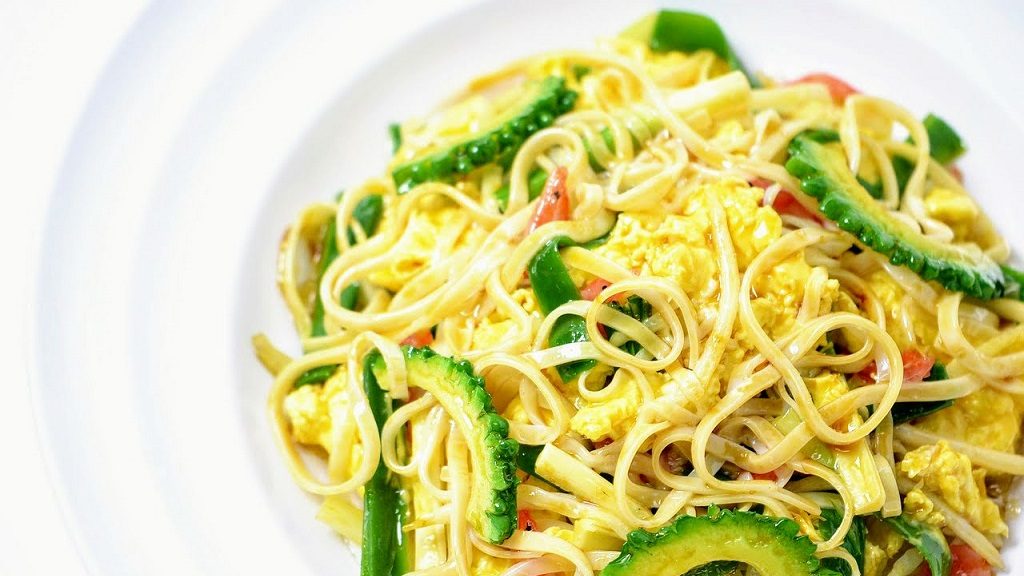
Goya champuru - stir-fried bitter melon is a distinctive Okinawan dish
Okinawan food, influenced by Chinese, Southeast Asian, native Ryukyu cooking (and even America post World War II), is distinct from traditional Japanese cuisine. Highlights include goya champuru (stir-fried bitter melon), Okinawan soba noodles, and the local Orion beer. Taking a food tour or cooking class is a great way to dive into this delicious local cuisine culture.
Okinawa Food Experiences
COOKING CLASSES
Ryukyu Cuisine Cooking Class in Okinawa
Why is Okinawa home to the most centenarians in the world? It might just have to do with the cuisine! Learn to cook Ryukyu cuisine with an English-speaking cooking instructor during this cooking class in Okinawa.From ¥10,000
COOKING CLASSES
Farm to Table in Okinawa: Brown Sugar and Banana Dessert
Join a local organic farmer in the sugarcane fields of Okinawa, try freshly squeezed sugarcane juice, tour the banana farm, and make a delicious dessert of caramelized bananas. Fun and interactive, this tour is perfect for anyone with a sweet tooth.FOOD TOURS
Tea Ceremony, Matcha-Making, & Kimono Experience
Join a unique hands-on learning experience guided by a tea ceremony expert in Okinawa. Change into a simple kimono, watch a Japanese tea ceremony, learn etiquette & customs, enjoy Okinawan sweets, make matcha, & participate in a photoshoot.From ¥11,000
Explore Ryukyu history and culture
In addition to Shuri Castle, Okinawa is home to numerous historic sites and museums that delve into the region's unique Ryukyu heritage. Must-visits include the Okinawa Prefectural Museum & Art Museum in Naha, the Ryukyu Mura living history museum, and the Okinawa Harborview Park with its reconstructed Ryukyu-style buildings.

Okinawa Prefectural Museum & Art Museum in Naha contains exhibits recording the region's Ryukyu heritage
Snorkel or dive the coral reefs
Okinawa's clear, warm waters and thriving coral reefs make it a top snorkelling and diving destination. The most popular spots on Okinawa Island is the Blue Cave, and nearby islands include the Kerama Islands and Miyako Island.

Okinawa is the perfect place in Japan for snorkelling or diving - here's me back in 2010
My wife and I have both snorkelled in Okinawa, and I’m not a very good swimmer - so don't let that stop you trying it. You can book with a local specialist, who will give you a safety briefing, some pointers and tips and guide you to the best spots the island has to offer. This is one of the biggest 'no-brainer' times to pay for an authorised, experience operator.
Hike to scenic viewpoints
For a dose of nature, head out on hiking trails that wind through Okinawa's lush, subtropical rainforests in the northern half of the island. The rich nature of Yanbaru National Park and Daisekirinsan are popular locations. There are some impressive vistas, with the Hiji Falls a particularly scenic option, while stunning cliffs and curious rock formations can be found on a walk around Cape Manzamo, also on the main island.

Okinawa has some comfortable hiking routes with spectacular views
Scaling the heights of nearby Ishigaki Island's Mt. Omoto, the highest peak in Okinawa, treats the adventurous to magnificent views of the surrounding ocean. Additionally, observatories situated on the islands within the Keramashoto National Park provide equally breathtaking panoramas.
Okinawan festivals and events
Okinawa is home to a vibrant calendar of festivals and events that showcase the islands' rich cultural heritage. Some of the most notable are:
Okinawa International Movie Festival (April)
Celebrating Okinawa's growing film industry, this festival screens local independent and international films with a focus on the Ryukyu culture.
SEE: Official Okinawa International Movie Festival
Haarii/Haarei Dragon Boat Races (May)
Teams of local men race dragon-shaped boats amid rituals of tribute to sea gods. Races have been staged since the 14th century, and today's races arose from the mixing of two traditions: the fishermen's races on the sea and the dragon boat ceremonies performed on rivers and lakes in China.
Eisa Festival (August)
Held in mid-August, Eisa is a traditional Okinawan folk dance performed during the Obon season to honour ancestral spirits. This festival in Naha features lively drum and dance performances. Dances vary from troupe to troupe, performers wearing colourful costumes perform with taiko drums, paranku (small Okinawan hand drums), and the sanshin, a traditional Okinawan stringed instrument.
Top Okinawa Day Trips
WATER ACTIVITY
Kerama Island Snorkeling Day Trip with Lunch
DAY TRIP
Day Trip to Tokashiki Island's with Lunch
Enjoy round-trip transfer from Tomari Port by ferry on this day tour. Swim in clear sea waters. Encounter the beauty of nature on the Kerama Blue water. Enjoy swimming in the beautiful sea. Relax on the white-sand shores along waters that are separated into swimming and snorkeling zones. Take a leisurely walk around and feel the tropical mood.WATER ACTIVITY
Kerama Islands Full-Day Intro-Diving Trip
Naha Tug-of-War Festival (October)
Dating back to the 15th century, this lively free festival in Naha pits two teams of over 15,000 people against each other in a massive tug-of-war competition using a 200-metre (656ft), 43-ton rope.
Shuri Castle Festival (October/November)
Held annually at the historic Shuri Castle park, this festival features traditional Ryukyu music and dance performances, craft demonstrations, and food stalls. The castle is illuminated at night with more than 6,000 lights.
These are just a few examples. As is true wherever you are in Japan, attending a local festival is an excellent way to immerse yourself in the region's heritage and customs, but those in Okinawa definitely have their own distinctive flair.
Introducing the Yaeyama Islands
In addition to the main Okinawa Island, the Yaeyama island chain is another must-visit part of Okinawa Prefecture. Located at the southernmost tip of Japan, the Yaeyama islands are a series of remote, rugged and tropical landscapes. To get here from Okinawa Island you'll need to catch a flight, typically to Ishigaki, and start from there, as its the most well-connected of the Yaeyama Islands.

Kabira Bay on Ishigaki is probably the most photographed spot in all the Yaeyama Islands - it deserves it!
The main islands include Ishigaki, Iriomote, and Taketomi, each offering a unique slice of Okinawan culture and natural beauty. Ishigaki is the most populous and developed, with a lively port town, excellent diving sites, and Mount Omoto - the highest peak in the Yaeyamas.
VIDEO: Kayaking and Trekking on Iriomote Island, Okinawa
Just a short ferry ride from Ishigaki, Iriomote is a heavily-forested island known for its mangrove channels, waterfalls, and rare Iriomote wildcat. A great place to go kayaking. Meanwhile, tiny Taketomi exudes old-world Okinawan charm, with traditional red-tiled 'shisa' houses and ox-drawn carts transporting visitors.

Okinawa's coastline is shaped by strong ocean waves, often carving beautiful caves
Getting to the Yaeyama Islands typically requires flying from the main Okinawa Island to Ishigaki, and either using that as your base, or using it as a staging point for onward travel to the other islands (usually by ferry). However, the extra effort is well worth it to experience the stunning natural landscapes, vibrant coral reefs, and cultural uniqueness of this remote island chain.
How to get to and around Okinawa
By air
Okinawa is easily accessible by air. Naha Airport on the main island is the region's primary airport, handling both domestic and international routes. Flights from major Japanese cities include Tokyo (2h 40m), Osaka (2h 10m), Sapporo (3h 50m). Flights to the ‘hub’ Yaeyama islands of Ishigaki take 1h.
Services to international hubs including Shanghai (2h 25m), Seoul (2h 25m), Taipei (1h 35m), Singapore (5h 15m) and Hong Kong (2h 40m) also operate.
My wife and I tend to use Skyscanner to search for flights to Japan. (TIP: Use their price alert feature to get notifications of price changes.)
Search flights to Okinawa
By sea
Several ferry companies operate services connecting the main Okinawa Island with several ports on Kyushu, including routes from Kagoshima. The journey time can range from 2-6 hours depending on your departure point. The Visit Okinawa Japan website has further information on ferry services and routes.
Within Okinawa
Getting around Okinawa using public transport isn't as straightforward as it is on Japan’s four largest islands as there's no rail network. A monorail does run between Okinawa Airport on the southern tip of the island up into the northern part of the capital Naha.
The road network though is well-developed, with routes hugging the coastline for the entire island, so renting a car (or hiring a taxi) is a great option for exploring the coastline and less-populated and developed areas - mainly in the north - at your own pace. Inland there are fewer roads.

The Okinawa monorail runs between Okinawa Airport and the northern edge of the capital Naha
Several bus companies provide services covering most of Okinawa. The Okinawa by Bus page on the Official Okinawa Travel Guide website is a good place to start to get your bearings on the options.
Okinawa supports an extensive network of ferry services connecting parts of the main island to each other as well as serving neighbouring islands, especially the Yaeyama Islands to the south. Express services operate on most of the major routes. But, as always, services and journey times can be disrupted or delayed depending on the weather.
Bicycle rental (both pedal and battery powered) is a great choice on Okinawa, particularly if you want to explore the inland areas where the road network falls short. There are also guided e-bike tours you can book to make the experience as easy as possible.
Where to stay in Okinawa
Okinawa’s accommodation is heavily skewed towards modern hotels and resorts with western style rooms. Traditional ryokan are almost entirely absent, but there are a small number of guesthouses.
In Naha, the capital city, high end options include the modern Hyatt Regency Naha, and the stylish Ritz-Carlton Okinawa. A little further north up the coastline the Hotel Monterey Okinawa Spa & Resort is worth considering.
Half way up on Okinawa's northern coast is the village of Onna and Halekulani Okinawa. Facing the beachfront, it offers 5-star accommodation and has a fitness centre, circular outdoor pool and terrace with a fantastic view out over the turquoise ocean. Luxurious interior design, with large, well-equipped rooms.
The Okinawa Prince Hotel Ocean View Ginowan is a bit of a mouthful, but is situated 600 metres from Tropical Beach (popular with locals) and a 20 minute drive from Naha. A resort style hotel, it includes the favourite amenities - outdoor swimming pool, a fitness and spa centre, restaurant, bar, terrace and includes free private parking. There's a 24-hour front desk, concierge service and currency exchange for guests. Also offers a free airport shuttle bus from the hotel entrance.
Get the celebrity treatment with world-class service at the Ryukyu Hotel & Resort Nashiro Beach in Itoman - 20 minutes south of Okinawa Airport. I can personally vouch for this one, as my wife and I have stayed here, and loved it! It has its own private beachfront, with no less than 6 pools. It's 200 metres from Nashiro Beach and 400 metres from Kitanashiro Beach. There's also an indoor pool, a 24-hour front desk and free WiFi.
4-Star Recommendations
Set in Onna village, less than 1 km from Seragaki Beach, Hoshino Resorts BEB5 Okinawa Serakaki offers accommodation with free bikes, free private parking, an outdoor swimming pool and a fitness centre with sauna, restaurant and a garden. The entire property is non-smoking and is located 1.4 km from Diamond Beach.
Large rooms, comfortable and huge beds, great view of the pool, quiet area but still has a Lawson konbini nearby as well as food options. This is a good choice for a staycation. Many public beaches nearby are peaceful and still beautifully pristine. Guests praise the staff as being super friendly. Public transport is infrequent and limited, so access with a hire car or taxi is a good idea
If you want to be located in the heart of the capital Naha, the JR Kyushu Hotel Blossom Naha is centrally located between the Midorigaoka Park and Kibogaoka Park, just off Okinawa's main street of Kokusaidori (popular for its department stores, restaurants specialising in Onikawan cuisine, and boutique and souvenir shops). It's highly rated for its very comfy beds, has a restaurant, offers free Wi-Fi, and private parking is available on site for an additional fee. The hotel is completely non-smoking and fully equipped with wheelchair access and facilities for disabled guests.
VIDEO: Ronsard Resort Irabu - Private Miyako Island Villa
If your plans include Miyako Island and you want a private villa just for yourself, then the modernist-styled, ocean fronted Ronsard Resort Irabu is definitely worth a look. It has 5 rooms, and the largest private (infinity) pool on the island. There's also a hot tub jacuzzi, free private parking, a garden, kitchen and a terrace overlooking the coral reef coastline. Free WiFi and room service are both included. Shimojishima Airport is only a 9-minute drive from the accommodation.
3-Star Recommendations
Situated within 1.2 km of Sunset Beach and 2.4 km of Araha Beach, Cococious Monpa offers rooms in Chatan. Featuring a restaurant, the 3-star hotel has air-conditioned rooms with free WiFi, each with a private bathroom. The accommodation features a 24-hour front desk, and luggage storage for guests. At the hotel, each room comes with a balcony with a sea view. Popular with solo travellers. a wide variety of excellent restaurant choices within walking distance. Breakfast is included in the price.
Set in Ginowan, 2.8 km from Araha Beach, The Grand Hotel Ginowan offers accommodation with a terrace, free private parking and a restaurant. With free WiFi, this 3-star hotel offers a 24-hour front desk and a tour desk. Some rooms feature a balcony with a city view. Guests at the hotel can enjoy a buffet or a continental breakfast.
The Moana by DSH Resorts is located in Chatan, within 2.9 km of Kadena Marina Beach and 2.9 km of Sunset Beach. Featuring a terrace, the 3-star hotel has air-conditioned rooms with free WiFi, each with a private bathroom. The property is non-smoking and is situated 1.5 km from Sunabe Beach. All rooms at the hotel are fitted with a flat-screen TV and a kitchen. Rooms are quiet, large and neat. There's plenty of restaurants (including those with vegan options) close by.

The Shureimon Gate is the entrance to Shuri Castle in Naha, often called the 'red castle'
Latest Okinawa Hotel Deals via Booking.com
Top 5 Okinawa travel FAQ
Here are some top frequently asked questions about travelling to Okinawa Island:
1. What is the best time of year to visit Okinawa?
The best time to visit Okinawa is typically from March to May and from September to November when the weather is mild and sunny. July and August can be extremely hot and humid, while December to February is cooler but with a higher chance of rain.
2. How do I get to Okinawa?
Okinawa has its own international airports, including Naha Airport on the main island. Many visitors fly into Naha from major Japanese cities like Tokyo, Osaka, or Fukuoka. There are also some international flights from nearby Asian countries like Taiwan, South Korea, and China. I use the Skyscanner website to get the best flight prices from a wide range of airlines.
3. What are the must-see attractions in Okinawa?
Some of the top attractions include Shuri Castle in Naha, the Okinawa Churaumi Aquarium, the scenic Kerama Islands, the former battlefields of World War II, beautiful beaches like Manza Beach, and exploring the unique Ryukyu culture through cuisine, crafts, and festivals.
4. Is Okinawa affordable to visit?
Compared with major cities in Japan, Okinawa is relatively affordable for food, accommodation, and attractions. However, travel costs to reach the islands can be quite high from the mainland. Budgeting carefully and finding discounts on airfares and accommodation can help make it an affordable getaway.
5. What is the food like in Okinawa?
Okinawan cuisine is heavily influenced by its location, climate and surrounding oceans. Popular dishes include Goya Chanpuru (bitter melon stir fry), Rafute (braised pork belly), and a variety of dishes using seafood and pork. Okinawan soba noodles and Awamori liquor (made from long grain indica rice) are also local specialties to try. Read this post: Discover Okinawan Food: Japan’s Life-Giving Diet to find out more.
Conclusion: it's completely different
Okinawa Island feels completely different to the rest of Japan largest islands. Its subtropical climate, international neightbours and ancient Ryukyu Kingdom history combine to create an entirely distinct region.
Everything from the landscape (more jungles than mountains) to its fusion food culture stands it apart.
If you're looking for somewhere to escape the hustle and bustle of Japan's big cities, where you can relax and unwind, make the most of its beautiful coastline and resort-style accommodation, then Okinawa is perfect for you.
If you found this post helpful feel free to share this:
Resources
Okinawa Destinations & Experiences (Featured Posts)
10 Regional Types Of Japanese Ramen You Need To Try
12 Must-Try Outdoor Activities In Japan
Adventures in the Yaeyama Islands
Discover Okinawan Food: Japan’s Life-Giving Diet
Driving In Japan Made Easy – A Beginner’s Guide
Driving in Japan: Kyushu or Okinawa?
Kayaking and Trekking on Iriomote Island
Okinawa YouTube Video Playlist
View my YouTube video playlist dedicated to Okinawa HERE
Okinawa Official Tourism Site
Japan Island Guides
To see all of my Japan Island Guides CLICK HERE
Okinawa Travel Planning Services
Have questions about exploring Okinawa? Need help planning an itinerary that includes Okinawa? I offer some Japan Travel Planning Services you might find helpful.
Japan travel guides, planning and booking resources (including Japan Rail Passes, WiFi, eSIMs, and more) are available in my Japan Travel Store.


